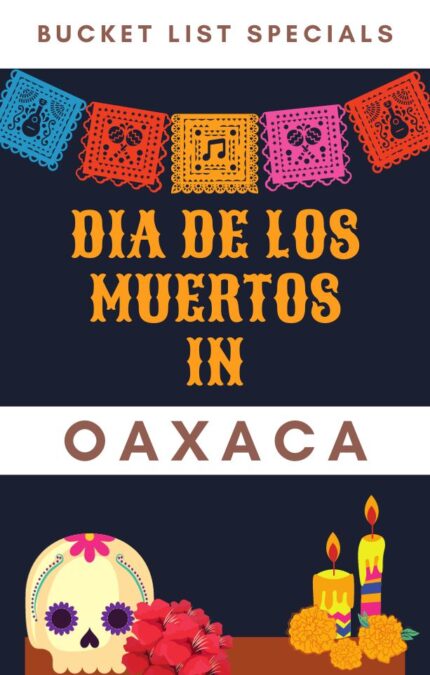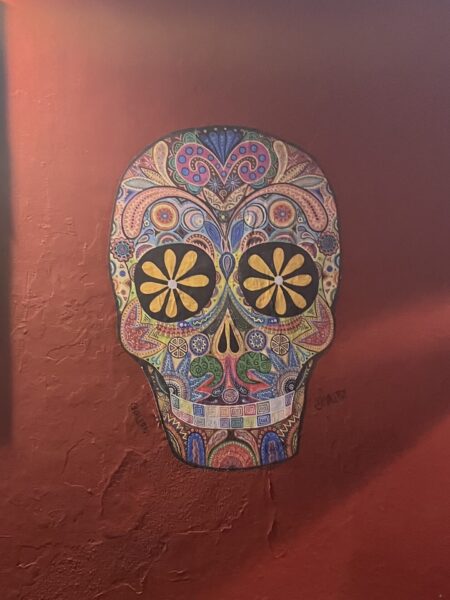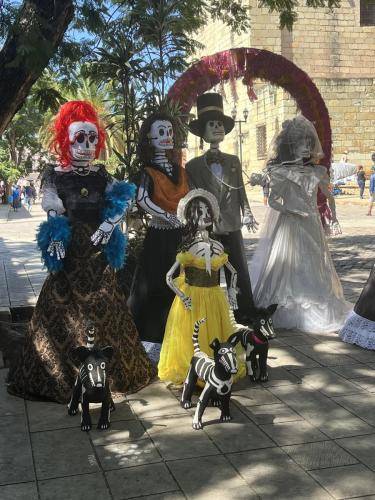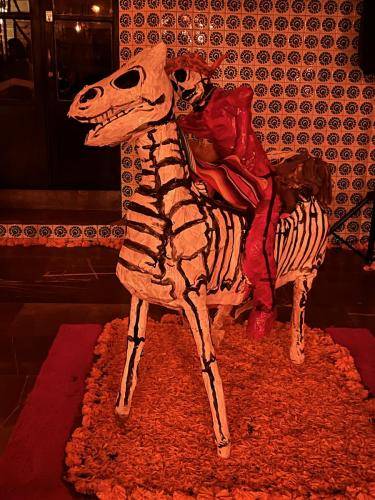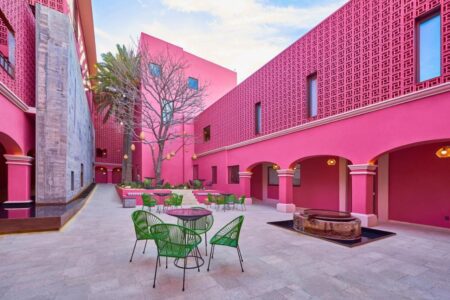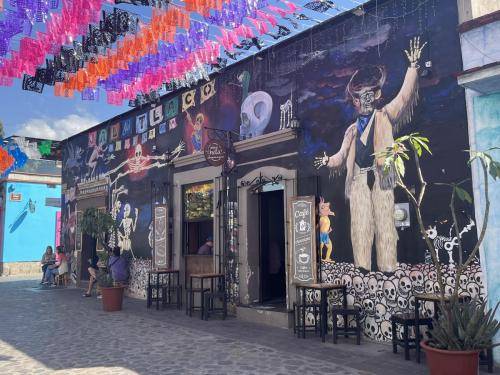The Day of the Dead is a holiday celebrated in many parts of Mexico, and Oaxaca is no exception. Every year on the 1st and 2nd of November, locals gather to remember their ancestors and pay homage to the dead. The streets of Oaxaca become filled with vibrant colors and elaborate decorations honoring the occasion, Comparsas are held just about everywhere, and the smell of Cempasúchil and Pan de Muertos fills every corner of the city.
Visiting Oaxaca during the Day of the Dead is an unforgettable experience that will leave lasting impressions on anyone who visits. The captivating customs, colorful imagery, and delicious food make every moment of one’s experience in Oaxaca during the Day of the Dead truly special. Whether you’re visiting for its rich history, unique culture, or fantastic foods, Oaxaca is the perfect destination to experience the Day of the Dead in its full glory.
Here you will find all the most important information on how to get the most out of your visit to Oaxaca during this iconic celebration.
For more information, check out this article with the overview of my visit to Puebla and Oaxaca in 2022.
Basic info
El Dia de Muertos is a Mexican tradition that has become so famous and iconic that its aesthetic has extended internationally. Visiting Mexico in the days surrounding November 1st is an iconic and unforgettable experience as many cities take on an otherworldly aspect.
The city of Oaxaca is arguably the best place to witness the Day of the Dead. Despite the city being the most famous destination for foreign visitors, it maintains its traditions and culture. Also, Oaxaca is a culinary paradise where you can eat chocolate, mole, and taste mezcal while admiring and immersing yourself in the celebrations.
About
The Day of the Dead (El Día de los Muertos) is a Mexican holiday held annually on the 2nd of November and is celebrated all over Mexico. Its iconic aesthetic has spilled internationally, and it is easy to see its influences elsewhere in the world, but witnessing and participating in it in Mexico is a truly unique experience.
There is no clear origin to the festival, with some indications that it may have had pre-Columbian roots and tying it to the Aztecs, while others believe it was a more recent reinterpretation and personalized view of old medieval European traditions.
The European influences are undeniable, but the Dia de los Muertos has developed its own unique aesthetic and traditions. The most obvious difference with All Saints Day is, for example, that it has a much less solemn tone and is portrayed as a holiday of joyful celebration rather than mourning. Also, when comparing it to Halloween or the original Hallow’s Eve, the differences are striking, with a much more pronounced embracement of death rather than its rejection or orientation towards scary aspects of it.
Festivity days
A brief breakdown of the different days:
- The days and weeks leading up to October 31st are preparation days. Despite not being part of the Day of the Dead, the cities are preparing for the famous celebration days and are mostly dedicated to decorations, baking, cutting marigold flowers, and creating altars and sand rugs.
- The 31st of October is heavily influenced by Halloween, which in turn is influenced by the specific aesthetics and traditions of the Day of the Dead.
- November 1st is the Día de los Inocentes – the day of the innocents – a day to remember the children who have passed.
- November 2nd is officially the Dia de los Muertos – the day of the spirits of adults who have passed.
Day of the Dead traditions
When it comes to aesthetics, the main characteristic of the Day of the Dead is the iconic altars decorated with marigold flowers (cempasúchil). The altars are created in homes and also in places open to the public, each one with varying themes (from more somber altars dedicated to a family member to religious Catholic altars to altars dedicated to pets, skeletons on bicycles, or only artistic altars with complex designs made of fruit or flower decorations).
While Day of the Dead altars are typically on display at private homes, there are several made by hotels, in the neighborhoods, and in open houses that you can see while you’re wandering around the streets.
Decorations extend to the streets in general, with paper machè calaveras – skulls – propped up almost everywhere. Walking around the streets and looking at buildings, you will see all these skeletons sitting on roofs and hanging from windows.
Sand paintings: Originally meant to remember and pay homage to the recent loss of a person and being kept for 9 days, the tapetes de arena have become part of the Day of the Dead tradition. They are meant to recall the Biblical phrase, “You are but dust, and to dust you shall return”. Today, they are made as decorations, are often seen as part of altars, and can be incredibly complex and large, taking hours to make.
A famous tradition during the days prior to the Dia de los Muertos is visiting cemeteries. Family members will “dress up” tombs and graves and gather around in that unique mix of somber yet joyful celebration of the deceased. The flowers and decorations create an otherworldly (no pun intended) atmosphere.
All nights are characterized by parades (Comparsa). The streets become rivers of people who follow the band playing music. This is the most communal and enjoyable experience, as you will follow giant paper machè figures being pranced around, witness people dressed as zombies or skeletons lying on the ground playing dead, and have the “patron” serve Mezcal to everyone to keep the spirits up.
Speaking of parades, during the evening celebrations of the Day of the Dead, it is common to undergo face painting. While this is not an original tradition, it has become widespread and almost mandatory. Having your face painted with a white base tone and black lines resembling a skeleton is a must-do experience. It is also a good way not only to immerse yourself in the atmosphere but also to be respectful and not be too much of a tourist. Participating in a parade with your face painted will make you blend in with everyone else.
Pan de Muertos is traditionally eaten only in October, and the smell of bakeries on full steam preparing all kinds of bread from the dead pervades the city.
Itinerary – What to do
If you want to experience the Day of the Dead to its fullest, get there at least 2,3 days earlier – around the 29th of October, and just wander around the streets to witness the essence of the festival slowly taking over the city. The Mercados will be filled with fresh-cut flowers (the cempasúchil flowers), bakeries will be busy making pan de muerto, and just about everywhere decorations will be put out in place.
Before October 31st
Marigold flower fields: For an iconic experience, travel outside the city to Cultivos el Viejo, a flower field near the town of Zimatlá, one hour away from Oaxaca. The large field with gold yellow and orange marigold flowers is beautiful, just take note that these flowers are harvested for decorations, so you will need to get there before the 30th
Tapetes de Arena: The most famous place where the sand rugs can be admired is in Zaachila, but other communities closer to the city center of Oaxaca, such as Xochimilco and Xoxocotlan, also display them.
This is also a good time to explore the city and surroundings of Oaxaca and everything that can be found year-round. On the culinary side, Oaxaca is considered a foodie paradise and the birthplace of the famous mole found everywhere in Mexico. There is also a long tradition of chocolate, and Oaxaca is famous for its production of mezcal, the higher-end, more slowly brewed, and arguably better-tasting cousin of tequila.
There are also several famous sites nearby, such as the Zapotec ruins of Monte Alban and Mitla, the largest tree in the world at El Tule, and the “frozen” (actually calcified) waterfalls and pools of Hierve el Agua. For more information on what to see in Oaxaca beyond everything that revolves around the Day of the Dead, check out this article.
October 31st
Visit cemeteries: the cemetery of Xoxocotlán is the most famous, but the tradition of families visiting cemeteries and decorating them can be found in all of them, such as Atzompa, Xochimilco, and San Felipe. Note that it may be colorful and fascinating, but as mentioned below in the Etiquette section, remember the setting you’re in and that you are visiting a place of mourning and observing families paying homage to their loved ones.
Celebrate the evening and night of Halloween: The influence of Halloween is undeniable, especially in younger generations. The night of the 31st is therefore a “normal” and more international celebration of Halloween, but with clear local influences. Walk around the city center and see all the people dressed up in costumes. There will also be more traditional and somber sights, such as candlelight processions and choruses.
November 1st
If you have been staying for some days, you will have grown accustomed to the parades of the previous days, which were simply preparations. They will now grow and increase in volume and people.
The most famous parade is the Muerteada in Etla, a 40-minute drive from Oaxaca. Here, male participants dress up in the most unsettling costumes, adorned with mirrors and bells, and wander around the streets in an attempt to scare the witches away and guide the spirits and ghosts through the night. The parade lasts all night until sunrise.
November 2nd
The Día de los Muertos proper. At night, the city will be filled with even more parades. While the most famous one is the one that starts in Barrio Jalatlaco, you can find them almost everywhere. Just listen for the telltale signs of massive music and waves of people moving towards or away from the river of people parading through the streets.
The evening is an overload of music, and Mezcal is filled with partying. Concerts are also held. Late at night, clubs will be pumping loud music that can be heard everywhere. Personally, I also witnessed an unsettling silent parade of people on bicycles, all dressed up as devils, skeletons, etc., quietly cycling through the streets.
Where to stay
Oaxaca is cheap because it is on a less-beaten path when compared to other destinations in the country, such as the Yucatan Peninsula or Mexico City surroundings. However, during these days, prices not only skyrocket but availability is also an issue, so it is best to book everything in advance (at least a couple of weeks, better a month before).
Luxury
Boutique & Eco-friendly
Budget & Local experience
Etiquette
- Despite visiting cemeteries being part of the tradition and being a tourist attraction, remember the place you’re in and the fact that it is a moment of mourning and a gathering of families around the burial sites of their deceased loved ones. As such, be respectful and understand the setting and mood. Some cemeteries have also been closed to foreigners during these days because of the chaos that they bring, with street vendors setting up shop, tons of noise, etc.
- I said before that it is like a carnival on steroids. That may be true in some sense, but it is also a festival that revolves around family, community, and the past. Excessively drinking and being too over the top should be avoided, not least as a visitor and the risks that being intoxicated can entail.
- When it comes to private displays, such as altars inside open houses, a tip is not required, but some places will have an offering box.
- Oaxaca is a tourist magnet in this period and it is good manners to ask permission when taking photographs
- There are many street performers carefully dressed up, and they expect to receive a small offering or tip (Propina) for taking pictures of or with them.
Getting around
Most attractions lie within the city center, and everything is within walking distance. It is enjoyable to walk around the colorful streets. A big part of the attractiveness of the city comes from strolling through its downtown streets.
Taxis are also widely available throughout the city and the town center.
Driving is easy, like in other Mexican towns (see here for some driving tips within Mexico) but it is not the best way to move around the city.
As with other Mexican towns, most locals get around either by car or through collectivos (buses to other pueblos).
Weather
The surroundings of the city will delight with their desertic, cactus-ridden plains, as Oaxaca has a tropical savanna climate. The city is located at a relatively high altitude (1500m), therefore the sun hits hard, and at night the temperatures drop quite considerably (to around 10°C).
The Day of the Dead falls right between the end of the wet season and the beginning of the dry season. As such, there may be some rain and a cooler temperature, but usually the weather is good, with daytime highs averaging 27.1 °C.
Guided tours
There are two ways to enjoy the festivities: either wandering around solo while absorbing the culture and taking the occasional taxi or collectivo bus to more areas outside of town, or taking guided tours to the most popular and iconic spots. Several guided tours offer visits to the nearby cemeteries or Mezcal tastings. If traveling without guides, it is best to stop at the tourist booth located in the main Zocalo and pick up a schedule of all the events happening around you.
